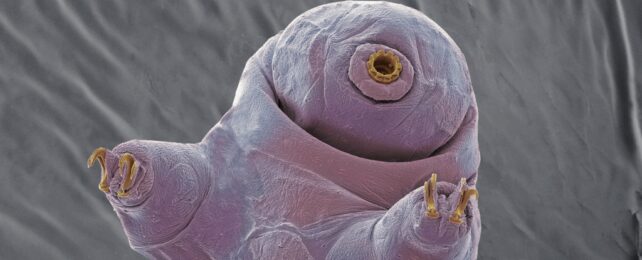Tardigrades are possibly the most indestructible animal on Earth. These microscopic little beasties can take almost anything humans throw at them, and waddle away perfectly intact on their eight stubby little legs.
The strategies behind these feats of superheroic survival are multiple, from a damage suppressor protein that literally protects their DNA, to a dehydrated, suspended animation 'tun' state that they can enter when external conditions get untenable.
And now, scientists have uncovered a new one. They're able to turn up the dial on damage repair to 11.
Led by biologist Courtney Clark Hachtel of the University of North Carolina at Asheville, a team blasted tardigrades with gamma rays, and watched to see how they responded.
"What we saw surprised us," says biologist Bob Goldstein of The University of North Carolina at Chapel Hill. "The tardigrades are doing something we hadn't expected."
We've known about tardigrades' fascinating resistance to ionizing radiation for decades. They can survive around 1,000 times the dose that would be lethal to humans, and continue going about their tiny lives as though it were nothing.
The damage suppression protein, Dsup, is thought to play a role in this for some tardigrades, but not all tardigrade species have Dsup or a homolog thereof, suggesting that there is some other means of survival at play.
To figure it out, the researchers investigated the effect of gamma radiation on a species of tardigrade called Hypsibius exemplaris. They placed tardigrades in a benchtop irradiator that exposed the critters to gamma rays emitted by the beta decay of cesium-137. Since the amount of radiation is known, they were able to expose the tardigrades to specific doses – one lower dose that is within tolerable levels, and a much higher median lethal dose.
To their surprise, although H. exemplaris does have Dsup, the radiation exposure didn't seem to trigger it. In fact, the tardigrades' DNA took a pretty big whack of radiation damage.
Rather than prophylactic protection, the tardigrades ramped up production of DNA repair genes to such a degree that their products became some of the most abundant in their microscopic bodies. By 24 hours after radiation exposure, the tardigrades had repaired most of the DNA broken by ionizing radiation.
In a follow-up, the researchers expressed some of the tardigrade repair genes in a culture of Escherichia coli, and exposed samples of the bacterium to ionizing radiation. Bacteria that had been inoculated with tardigrade genes showed a similar DNA repair ability to that seen in H. exemplaris, but not seen in untreated E. coli.
This suggests, the researchers found, that H. exemplaris is able to sense ionizing radiation, and mount a response that allows it to survive doses that would obliterate other animals.
"These animals are mounting an incredible response to radiation, and that seems to be a secret to their extreme survival abilities," says Clark-Hachtel. "What we are learning about how tardigrades overcome radiation stress can lead to new ideas about how we might try to protect other animals and microorganisms from damaging radiation."
Well, what else would you expect from an animal that can survive being fired out of a gun?
The research has been published in Current Biology.
